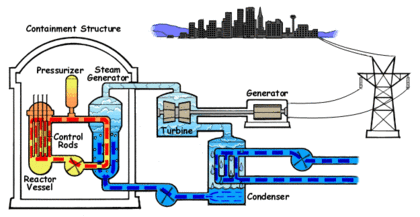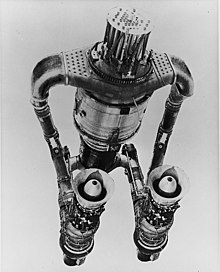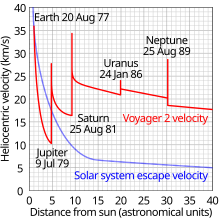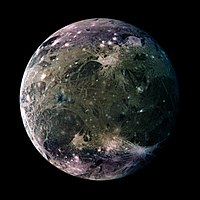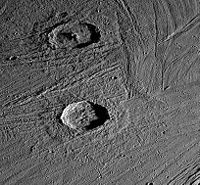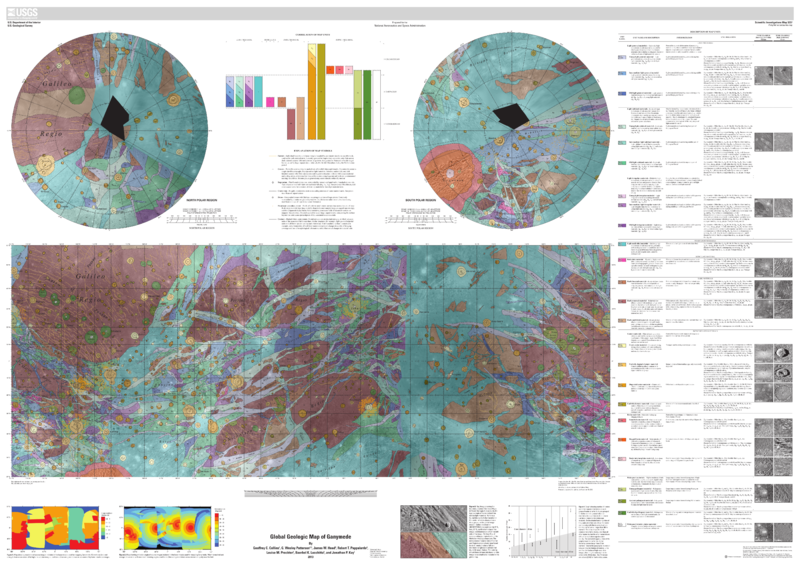From Wikipedia, the free encyclopedia
Ganymede (
Jupiter III) is the
largest and most massive moon of Jupiter and
in the Solar System.
The ninth largest object in the Solar System, it is the largest without
a substantial atmosphere. It has a diameter of 5,268 km (3,273 mi) and
is 8% larger than the planet
Mercury, although only 45% as massive. Possessing a
metallic core, it has the lowest
moment of inertia factor of any solid body in the Solar System and is the only
moon known to have a
magnetic field. It is the third of the
Galilean moons, the first group of objects discovered orbiting another planet, and the seventh
satellite outward from
Jupiter. Ganymede
orbits Jupiter in roughly seven days and is in a 1:2:4
orbital resonance with the moons
Europa and
Io, respectively.
Ganymede is composed of approximately equal amounts of
silicate rock and water ice. It is a fully
differentiated body with an iron-rich, liquid core, and an
internal ocean that may contain more water than all of Earth's oceans combined. Its surface is composed of two main types of terrain. Dark regions, saturated with
impact craters
and dated to four billion years ago, cover about a third of the
satellite. Lighter regions, crosscut by extensive grooves and ridges and
only slightly less ancient, cover the remainder. The cause of the light
terrain's disrupted geology is not fully known, but was likely the
result of
tectonic activity due to
tidal heating.
Ganymede's magnetic field is probably created by
convection within its liquid iron core. The meager magnetic field is buried within Jupiter's much larger
magnetic field and would show only as a local perturbation of the
field lines. The satellite has a thin
oxygen atmosphere that includes O, O
2, and possibly O
3 (
ozone).
Atomic hydrogen is a minor atmospheric constituent. Whether the satellite has an
ionosphere associated with its atmosphere is unresolved.
Ganymede's discovery is credited to
Galileo Galilei, who was the first to observe it on January 7, 1610.
The satellite's name was soon suggested by astronomer
Simon Marius, after the mythological
Ganymede, cupbearer of the
Greek gods, kidnapped by Zeus for the purpose. Beginning with
Pioneer 10, several spacecraft have explored Ganymede. The
Voyager probes,
Voyager 1 and
Voyager 2, refined measurements of its size, while
Galileo discovered its underground ocean and magnetic field. The next planned mission to the Jovian system is the
European Space Agency's
Jupiter Icy Moon Explorer
(JUICE), due to launch in 2022. After flybys of all three icy Galilean
moons, the probe is planned to enter orbit around Ganymede.
History
Chinese astronomical records report that in 365 BC,
Gan De detected what might have been a moon of Jupiter, probably Ganymede, with the naked eye.
However, Gan De reported the color of the companion as reddish, which
is puzzling since the moons are too faint for their color to be
perceived with the naked eye. Shi Shen and Gan De together made fairly accurate observations of the five major planets.
On January 7, 1610,
Galileo Galilei observed what he thought were three stars near Jupiter, including what turned out to be Ganymede,
Callisto, and one body that turned out to be the combined light from
Io and
Europa;
the next night he noticed that they had moved. On January 13, he saw
all four at once for the first time, but had seen each of the moons
before this date at least once. By January 15, Galileo came to the
conclusion that the stars were actually bodies orbiting Jupiter. He claimed the right to name the moons; he considered "Cosmian Stars" and settled on "
Medicean Stars".
Size comparison of Earth, the Moon, and Ganymede.
The French astronomer
Nicolas-Claude Fabri de Peiresc suggested individual names from the
Medici family for the moons, but his proposal was not taken up.
Simon Marius, who had originally claimed to have found the Galilean satellites,
tried to name the moons the "Saturn of Jupiter", the "Jupiter of
Jupiter" (this was Ganymede), the "Venus of Jupiter", and the "Mercury
of Jupiter", another nomenclature that never caught on. From a
suggestion by
Johannes Kepler, Marius once again tried to name the moons:
[…] Then there was Ganymede, the handsome son of King Tros,
whom Jupiter, having taken the form of an eagle, transported to heaven
on his back, as poets fabulously tell […] the Third, on account of its
majesty of light, Ganymede […]
This name and those of the other Galilean satellites fell into
disfavor for a considerable time, and were not in common use until the
mid-20th century. In much of the earlier astronomical literature,
Ganymede is referred to instead by its Roman numeral designation, Jupiter III
(a system introduced by Galileo), in other words "the third satellite
of Jupiter". Following the discovery of moons of Saturn, a naming system
based on that of Kepler and Marius was used for Jupiter's moons. Ganymede is the only Galilean moon of Jupiter named after a male figure—like Io, Europa, and Callisto, he was a lover of Zeus.
Orbit and rotation
Ganymede
orbits Jupiter at a distance of 1,070,400 km, third among the Galilean satellites, and completes a revolution every seven days and three hours. Like most known moons, Ganymede is
tidally locked, with one side always facing toward the planet, hence its day is seven days and three hours. Its orbit is very slightly eccentric and inclined to the Jovian
equator, with the
eccentricity and
inclination changing
quasi-periodically due to solar and planetary gravitational
perturbations on a timescale of centuries. The ranges of change are 0.0009–0.0022 and 0.05–0.32°, respectively. These orbital variations cause the
axial tilt (the angle between rotational and orbital axes) to vary between 0 and 0.33°.
Ganymede participates in
orbital resonances with Europa and Io: for every orbit of Ganymede, Europa orbits twice and Io orbits four times.
Conjunctions (alignment on the same side of Jupiter) between Io and Europa occur when Io is at
periapsis and Europa at
apoapsis. Conjunctions between Europa and Ganymede occur when Europa is at periapsis.
The longitudes of the Io–Europa and Europa–Ganymede conjunctions change
with the same rate, making triple conjunctions impossible. Such a
complicated resonance is called the
Laplace resonance.
Jupiter's Great Red Spot and Ganymede's shadow
The current Laplace resonance is unable to pump the orbital eccentricity of Ganymede to a higher value. The value of about 0.0013 is probably a remnant from a previous epoch, when such pumping was possible.
The Ganymedian orbital eccentricity is somewhat puzzling; if it is not
pumped now it should have decayed long ago due to the tidal
dissipation in the interior of Ganymede. This means that the last episode of the eccentricity excitation happened only several hundred million years ago. Because Ganymede's orbital eccentricity is relatively low—on average 0.0015—
tidal heating is negligible now. However, in the past Ganymede may have passed through one or more Laplace-like resonances that were able to pump the orbital eccentricity to a value as high as 0.01–0.02.
This probably caused a significant tidal heating of the interior of
Ganymede; the formation of the grooved terrain may be a result of one or
more heating episodes.
There are two hypotheses for the origin of the Laplace resonance
among Io, Europa, and Ganymede: that it is primordial and has existed
from the beginning of the Solar System; or that it developed after the
formation of the Solar System.
A possible sequence of events for the latter scenario is as follows: Io
raised tides on Jupiter, causing Io's orbit to expand (due to
conservation of momentum) until it encountered the 2:1 resonance with
Europa; after that the expansion continued, but some of the angular
moment
was transferred to Europa as the resonance caused its orbit to expand
as well; the process continued until Europa encountered the 2:1
resonance with Ganymede. Eventually the drift rates of conjunctions between all three moons were synchronized and locked in the Laplace resonance.
Physical characteristics
Depiction
of Ganymede centered over 45° W. longitude; dark areas are Perrine
(upper) and Nicholson (lower) regiones; prominent craters are Tros
(upper right) and Cisti (lower left).
Size
Ganymede is the largest and most massive moon in the Solar System. Its diameter of 5,268 km is 0.41 times that of
Earth, 0.77 times that of
Mars, 1.02 times that of Saturn's
Titan (the second-largest moon), 1.08 times
Mercury's, 1.09 times
Callisto's, 1.45 times
Io's and 1.51 times the
Moon's. Its mass is 10% greater than Titan's, 38% greater than Callisto's, 66% greater than Io's and 2.02 times that of the
Moon.
Composition
The average
density of Ganymede, 1.936
g/cm
3, suggests a composition of about equal parts rocky material and mostly water-ices. The
mass fraction of ices is between 46–50 %, which is slightly lower than that in Callisto. Some additional volatile ices such as
ammonia may also be present. The exact composition of Ganymede's
rock is not known, but is probably close to the composition of
L/
LL type ordinary chondrites, which are characterized by less total
iron, less metallic iron and more
iron oxide than
H chondrites. The weight ratio of iron to
silicon ranges between 1.05 and 1.27 in Ganymede, whereas the
solar ratio is around 1.8.
Voyager 2 view of Ganymede's anti-Jovian hemisphere; Uruk Sulcus separates dark areas Galileo Regio (right) and Marius Regio (center left). Bright rays of recent crater Osiris (bottom) are ejected ice.
Surface features
Ganymede's surface has an
albedo of about 43%. Water ice seems to be ubiquitous on its surface, with a mass fraction of 50–90 %, significantly more than in Ganymede as a whole.
Near-infrared spectroscopy has revealed the presence of strong water ice
absorption bands at wavelengths of 1.04, 1.25, 1.5, 2.0 and 3.0
μm. The grooved terrain is brighter and has a more icy composition than the dark terrain. The analysis of high-resolution, near-infrared and
UV spectra obtained by the
Galileo spacecraft and from Earth observations has revealed various non-water materials:
carbon dioxide,
sulfur dioxide and, possibly,
cyanogen,
hydrogen sulfate and various
organic compounds.
Galileo results have also shown
magnesium sulfate (MgSO
4) and, possibly,
sodium sulfate (Na
2SO
4) on Ganymede's surface. These salts may originate from the subsurface ocean.
The Ganymedian surface albedo is very asymmetric; the leading hemisphere is brighter than the trailing one. This is similar to Europa, but the reverse for Callisto. The trailing hemisphere of Ganymede appears to be enriched in sulfur dioxide. The distribution of carbon dioxide does not demonstrate any hemispheric asymmetry, although it is not observed near the poles.
Impact craters
on Ganymede (except one) do not show any enrichment in carbon dioxide,
which also distinguishes it from Callisto. Ganymede's carbon dioxide gas
was probably depleted in the past.
A
sharp boundary divides the ancient dark terrain of Nicholson Regio from
the younger, finely striated bright terrain of Harpagia Sulcus.
Enhanced-color Galileo spacecraft image of Ganymede's trailing hemisphere.
The crater Tashmetum's prominent rays are at lower right, and the large
ejecta field of Hershef at upper right. Part of dark Nicholson Regio is
at lower left, bounded on its upper right by Harpagia Sulcus.
Ganymede's surface is a mix of two types of terrain: very old, highly
cratered,
dark regions and somewhat younger (but still ancient), lighter regions
marked with an extensive array of grooves and ridges. The dark terrain,
which comprises about one-third of the surface,
contains clays and organic materials that could indicate the
composition of the impactors from which Jovian satellites accreted.
The heating mechanism required for the formation of the grooved terrain on Ganymede is an unsolved problem in the
planetary sciences. The modern view is that the grooved terrain is mainly
tectonic in nature.
Cryovolcanism is thought to have played only a minor role, if any. The forces that caused the strong stresses in the Ganymedian ice
lithosphere necessary to initiate the tectonic activity may be connected to the
tidal heating events in the past, possibly caused when the satellite passed through unstable
orbital resonances.
The tidal flexing of the ice may have heated the interior and strained
the lithosphere, leading to the development of cracks and
horst and graben faulting, which erased the old, dark terrain on 70% of the surface.
The formation of the grooved terrain may also be connected with the
early core formation and subsequent tidal heating of Ganymede's
interior, which may have caused a slight expansion of Ganymede by 1–6 %
due to
phase transitions in ice and
thermal expansion. During subsequent evolution deep, hot water
plumes may have risen from the core to the surface, leading to the tectonic deformation of the lithosphere.
Radiogenic heating
within the satellite is the most relevant current heat source,
contributing, for instance, to ocean depth. Research models have found
that if the orbital eccentricity were an order of magnitude greater than
currently (as it may have been in the past), tidal heating would be a
more substantial heat source than radiogenic heating.
Cratering is seen on both types of terrain, but is especially
extensive on the dark terrain: it appears to be saturated with impact
craters and has evolved largely through impact events.
The brighter, grooved terrain contains many fewer impact features,
which have been only of a minor importance to its tectonic evolution. The density of cratering indicates an age of 4 billion years for the dark terrain, similar to the highlands of the
Moon, and a somewhat younger age for the grooved terrain (but how much younger is uncertain). Ganymede may have experienced a period of heavy cratering 3.5 to 4 billion years ago similar to that of the Moon. If true, the vast majority of impacts happened in that epoch, whereas the cratering rate has been much smaller since.
Craters both overlay and are crosscut by the groove systems, indicating
that some of the grooves are quite ancient. Relatively young craters
with rays of ejecta are also visible.
Ganymedian craters are flatter than those on the Moon and Mercury. This
is probably due to the relatively weak nature of Ganymede's icy crust,
which can (or could) flow and thereby soften the relief. Ancient craters
whose relief has disappeared leave only a "ghost" of a crater known as a
palimpsest.
One significant feature on Ganymede is a dark plain named
Galileo Regio, which contains a series of concentric grooves, or furrows, likely created during a period of geologic activity.
Ganymede also has polar caps, likely composed of water frost. The frost extends to 40° latitude. These polar caps were first seen by the
Voyager
spacecraft. Theories on the formation of the caps include the migration
of water to higher latitudes and bombardment of the ice by plasma. Data
from
Galileo suggests the latter is correct.
The presence of a magnetic field on Ganymede results in more intense
charged particle bombardment of its surface in the unprotected polar
regions; sputtering then leads to redistribution of water molecules,
with frost migrating to locally colder areas within the polar terrain.
Geologic map
of Ganymede (February 2014). The oldest, low-albedo, cratered units are
reddish brown; younger, higher-albedo units are blue if grooved and
blue-green if smooth (purple is a mix of grooved and smooth).
A crater named
Anat provides the reference point for measuring longitude on Ganymede. By definition, Anat is at 128° longitude. The 0° longitude directly faces Jupiter, and unless stated otherwise longitude increases toward the west.
Internal structure
Ganymede appears to be fully
differentiated, with an internal structure consisting of an
iron-sulfide–
iron core, a
silicate mantle and outer layers of water ice and liquid water.
The precise thicknesses of the different layers in the interior of
Ganymede depend on the assumed composition of silicates (fraction of
olivine and
pyroxene) and amount of
sulfur in the core. Ganymede has the lowest
moment of inertia factor, 0.31, among the solid Solar System bodies. This is a consequence of its substantial water content and fully differentiated interior
Subsurface oceans
Artist's cut-away representation of the internal structure of Ganymede. Layers drawn to scale.
In the 1970s, NASA scientists first suspected that Ganymede has a
thick ocean between two layers of ice, one on the surface and one
beneath a liquid ocean and atop the rocky mantle. In the 1990s, NASA's
Galileo
mission flew by Ganymede, confirming the moon's sub-surface ocean. An
analysis published in 2014, taking into account the realistic
thermodynamics for water and effects of salt, suggests that Ganymede
might have a stack of several ocean layers separated by different
phases of ice, with the lowest liquid layer adjacent to the rocky
mantle. Water–rock contact may be an important factor in the
origin of life.
The analysis also notes that the extreme depths involved (~800 km to
the rocky "seafloor") mean that temperatures at the bottom of a
convective (adiabatic) ocean can be up to 40 K higher than those at the
ice–water interface. In March 2015, scientists reported that
measurements with the Hubble Space Telescope of how the aurorae moved
over Ganymede's surface suggest it has a subsurface ocean. A large
salt-water ocean affects Ganymede's magnetic field, and consequently,
its aurora. The evidence suggests that Ganymede's oceans might be the largest in the entire Solar System.
There is some speculation on the potential
habitability of Ganymede's ocean.
Core
The existence of a liquid,
iron–nickel-rich core provides a natural explanation for the intrinsic
magnetic field of Ganymede detected by
Galileo spacecraft. The
convection in the liquid iron, which has high
electrical conductivity, is the most reasonable model of magnetic field generation. The density of the core is 5.5–6 g/cm
3 and the silicate mantle is 3.4–3.6 g/cm
3. The radius of this core may be up to 500 km. The temperature in the core of Ganymede is probably 1500–1700 K and pressure up to 10 GPa (99,000 atm).
Atmosphere and ionosphere
In
1972, a team of Indian, British and American astronomers working in
Java (Indonesia) and Kavalur (India) claimed that they had detected a
thin atmosphere during an
occultation, when it and Jupiter passed in front of a star. They estimated that the surface pressure was around 0.1
Pa (1 microbar). However, in 1979,
Voyager 1 observed an occultation of the star
κ Centauri during its flyby of Jupiter, with differing results. The occultation measurements were conducted in the
far-ultraviolet spectrum at
wavelengths shorter than 200
nm, which were much more sensitive to the presence of gases than the 1972 measurements made in the
visible spectrum. No atmosphere was revealed by the
Voyager data. The upper limit on the surface particle
number density was found to be
1.5×109 cm−3, which corresponds to a surface pressure of less than 2.5 µPa (25 picobar). The latter value is almost five orders of magnitude less than the 1972 estimate.
False-color temperature map of Ganymede
Despite the
Voyager data, evidence for a tenuous
oxygen atmosphere (
exosphere) on Ganymede, very similar to the one found on
Europa, was found by the
Hubble Space Telescope (HST) in 1995. HST actually observed
airglow of
atomic oxygen in the far-ultraviolet at the wavelengths 130.4 nm and 135.6 nm. Such an airglow is excited when
molecular oxygen is
dissociated by electron impacts, which is evidence of a significant neutral atmosphere composed predominantly of O
2 molecules. The surface number density probably lies in the
(1.2–7)×108 cm−3 range, corresponding to the surface pressure of
0.2–1.2 µPa. These values are in agreement with the
Voyager's
upper limit set in 1981. The oxygen is not evidence of life; it is
thought to be produced when water ice on Ganymede's surface is split
into
hydrogen and oxygen by radiation, with the hydrogen then being more rapidly lost due to its low atomic mass.
The airglow observed over Ganymede is not spatially homogeneous like
that over Europa. HST observed two bright spots located in the northern
and southern hemispheres, near ± 50° latitude, which is exactly the
boundary between the open and closed field lines of the Ganymedian
magnetosphere (see below). The bright spots are probably polar
auroras, caused by plasma precipitation along the open field lines.
The existence of a neutral atmosphere implies that an
ionosphere should exist, because oxygen molecules are ionized by the impacts of the energetic
electrons coming from the magnetosphere and by solar
EUV radiation. However, the nature of the Ganymedian ionosphere is as controversial as the nature of the atmosphere. Some
Galileo
measurements found an elevated electron density near Ganymede,
suggesting an ionosphere, whereas others failed to detect anything. The electron density near the surface is estimated by different sources to lie in the range 400–2,500 cm
−3. As of 2008, the parameters of the ionosphere of Ganymede are not well constrained.
Additional evidence of the oxygen atmosphere comes from spectral
detection of gases trapped in the ice at the surface of Ganymede. The
detection of
ozone (O
3) bands was announced in 1996. In 1997 spectroscopic analysis revealed the
dimer (or
diatomic) absorption features of
molecular oxygen. Such an absorption can arise only if the oxygen is in a dense phase.
The best candidate is molecular oxygen trapped in ice. The depth of the
dimer absorption bands depends on
latitude and
longitude, rather than on surface
albedo—they tend to decrease with increasing latitude on Ganymede, whereas O
3 shows an opposite trend. Laboratory work has found that O
2 would not cluster or bubble but dissolve in ice at Ganymede's relatively warm surface temperature of 100 K (−173.15 °C).
A search for
sodium
in the atmosphere, just after such a finding on Europa, turned up
nothing in 1997. Sodium is at least 13 times less abundant around
Ganymede than around Europa, possibly because of a relative deficiency
at the surface or because the magnetosphere fends off energetic
particles. Another minor constituent of the Ganymedian atmosphere is
atomic hydrogen. Hydrogen atoms were observed as far as 3,000 km from Ganymede's surface. Their density on the surface is about
1.5×104 cm−3.
Magnetosphere
Magnetic
field of the Jovian satellite Ganymede, which is embedded into the
magnetosphere of Jupiter. Closed field lines are marked with green
color.
The
Galileo craft made six close flybys of Ganymede from 1995–2000 (G1, G2, G7, G8, G28 and G29) and discovered that Ganymede has a permanent (intrinsic)
magnetic moment independent of the Jovian magnetic field. The value of the moment is about
1.3 × 1013 T·m3, which is three times larger than the
magnetic moment of Mercury.
The magnetic dipole is tilted with respect to the rotational axis of
Ganymede by 176°, which means that it is directed against the Jovian
magnetic moment. Its north pole lies below the
orbital plane. The
dipole magnetic field created by this permanent moment has a strength of 719 ± 2
nT at Ganymede's equator, which should be compared with the Jovian magnetic field at the distance of Ganymede—about 120 nT. The equatorial field of Ganymede is directed against the Jovian field, meaning
reconnection is possible. The intrinsic field strength at the poles is two times that at the equator—1440 nT.
Aurorae on Ganymede—auroral belt shifting may indicate a subsurface saline ocean.
The permanent magnetic moment carves a part of space around Ganymede, creating a tiny
magnetosphere embedded inside
that of Jupiter; it is the only moon in the Solar System known to possess the feature. Its diameter is 4–5
RG (
RG = 2,631.2 km). The Ganymedian magnetosphere has a region of closed
field lines located below 30°
latitude, where
charged particles (
electrons and
ions) are trapped, creating a kind of
radiation belt. The main ion species in the magnetosphere is single ionized
oxygen—O
+—which fits well with Ganymede's tenuous oxygen
atmosphere. In the polar cap regions, at latitudes higher than 30°, magnetic field lines are open, connecting Ganymede with Jupiter's
ionosphere. In these areas, the energetic (tens and hundreds of
kiloelectronvolt) electrons and ions have been detected, which may cause the
auroras observed around the Ganymedian poles. In addition, heavy ions precipitate continuously on Ganymede's polar surface,
sputtering and darkening the ice.
The interaction between the Ganymedian magnetosphere and Jovian
plasma is in many respects similar to that of the
solar wind and Earth's magnetosphere.
The plasma co-rotating with Jupiter impinges on the trailing side of
the Ganymedian magnetosphere much like the solar wind impinges on the
Earth's magnetosphere. The main difference is the speed of plasma flow—
supersonic in the case of Earth and
subsonic in the case of Ganymede. Because of the subsonic flow, there is no
bow shock off the trailing hemisphere of Ganymede.
In addition to the intrinsic magnetic moment, Ganymede has an induced dipole magnetic field.
Its existence is connected with the variation of the Jovian magnetic
field near Ganymede. The induced moment is directed radially to or from
Jupiter following the direction of the varying part of the planetary
magnetic field. The induced magnetic moment is an order of magnitude
weaker than the intrinsic one. The
field strength of the induced field at the magnetic equator is about 60 nT—half of that of the ambient Jovian field. The induced magnetic field of Ganymede is similar to those of
Callisto and
Europa, indicating that Ganymede also has a subsurface water ocean with a high
electrical conductivity.
Given that Ganymede is completely differentiated and has a metallic core,
its intrinsic magnetic field is probably generated in a similar fashion
to the Earth's: as a result of conducting material moving in the
interior. The magnetic field detected around Ganymede is likely to be caused by compositional convection in the core, if the magnetic field is the product of dynamo action, or magnetoconvection.
Despite the presence of an iron core, Ganymede's magnetosphere
remains enigmatic, particularly given that similar bodies lack the
feature.
Some research has suggested that, given its relatively small size, the
core ought to have sufficiently cooled to the point where fluid motions,
hence a magnetic field would not be sustained. One explanation is that
the same orbital resonances proposed to have disrupted the surface also
allowed the magnetic field to persist: with Ganymede's eccentricity
pumped and tidal heating of the mantle increased during such resonances,
reducing heat flow from the core, leaving it fluid and convective.
Another explanation is a remnant magnetization of silicate rocks in the
mantle, which is possible if the satellite had a more significant
dynamo-generated field in the past.
Origin and evolution
Ganymede probably formed by an
accretion in Jupiter's
subnebula, a disk of gas and dust surrounding Jupiter after its formation. The accretion of Ganymede probably took about 10,000 years, much shorter than the 100,000 years estimated for
Callisto.
The Jovian subnebula may have been relatively "gas-starved" when the
Galilean satellites formed; this would have allowed for the lengthy
accretion times required for Callisto. In contrast Ganymede formed closer to Jupiter, where the subnebula was denser, which explains its shorter formation timescale. This relatively fast formation prevented the escape of accretional heat, which may have led to ice melt and
differentiation: the separation of the rocks and ice. The rocks settled to the center, forming the core.
In this respect, Ganymede is different from Callisto, which apparently
failed to melt and differentiate early due to loss of the accretional
heat during its slower formation. This hypothesis explains why the two Jovian moons look so dissimilar, despite their similar mass and composition. Alternative theories explain Ganymede's greater internal heating on the basis of tidal flexing or more intense pummeling by impactors during the
Late Heavy Bombardment. In the latter case, modeling suggests that differentiation would become a
runaway process at Ganymede but not Callisto.
After formation, Ganymede's core largely retained the heat
accumulated during accretion and differentiation, only slowly releasing
it to the ice mantle. The mantle, in turn, transported it to the surface by convection. The decay of
radioactive elements within rocks further heated the core, causing increased differentiation: an inner,
iron–
iron-sulfide core and a
silicate mantle formed. With this, Ganymede became a fully differentiated body.
By comparison, the radioactive heating of undifferentiated Callisto
caused convection in its icy interior, which effectively cooled it and
prevented large-scale melting of ice and rapid differentiation. The convective motions in Callisto have caused only a partial separation of rock and ice. Today, Ganymede continues to cool slowly. The heat being released from its core and silicate mantle enables the subsurface ocean to exist, whereas the slow cooling of the liquid Fe–FeS core causes convection and supports magnetic field generation. The current
heat flux out of Ganymede is probably higher than that out of Callisto.
Exploration
Completed missions
Several probes flying by or orbiting Jupiter have explored Ganymede
more closely, including four flybys in the 1970s, and multiple passes in
the 1990s to 2000s.
Pioneer 10 approached in 1973 and
Pioneer 11 in 1974, and they returned information about the satellite. This included more specific determination on physical characteristics and resolving features to 400 km (250 mi) on its surface. Pioneer 10's closest approach was 446,250 km.
Voyager 1 and
Voyager 2 were next, passing by Ganymede in 1979. They refined its size, revealing it was larger than
Saturn's moon
Titan, which was previously thought to have been bigger. The grooved terrain was also seen.
In 1995, the
Galileo spacecraft entered orbit around Jupiter and between 1996 and 2000 made six close flybys to explore Ganymede. These flybys are denoted G1, G2, G7, G8, G28 and G29. During the closest flyby—G2—
Galileo passed just 264 km from the surface of Ganymede. During a G1 flyby in 1996, the Ganymedian magnetic field was discovered, while the discovery of the ocean was announced in 2001.
Galileo transmitted a large number of spectral images and discovered several non-ice compounds on the surface of Ganymede. The most recent close observations of Ganymede were made by
New Horizons, which recorded topographic and compositional mapping data of
Europa and Ganymede during its flyby of Jupiter in 2007 en route to
Pluto.
Mission concepts
A Ganymede orbiter based on the
Juno probe was proposed in 2010 for the
Planetary Science Decadal Survey.
Possible instruments include Medium Resolution Camera, Flux Gate
Magnetometer, Visible/NIR Imaging Spectrometer, Laser Altimeter, Low and
High Energy Plasma Packages, Ion and Neutral Mass Spectrometer, UV
Imaging Spectrometer, Radio and Plasma Wave sensor, Narrow Angle Camera,
and a Sub-Surface Radar.
Another canceled proposal to orbit Ganymede was the
Jupiter Icy Moons Orbiter. It was designed to use
nuclear fission for power,
ion engine propulsion, and would have studied Ganymede in greater detail than previously. However, the mission was canceled in 2005 because of budget cuts. Another old proposal was called The Grandeur of Ganymede.
